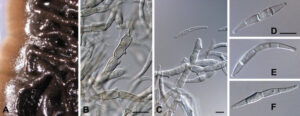Camptophora hylomeconis (Crous, de Hoog & H.D. Shin) Réblová & Unter., PLoS ONE 8(5): e63547, 14 (2013)
≡ Cyphellophora hylomeconis Crous, de Hoog & H.D. Shin, Stud. Mycol. 58: 200 (2007)
Index Fungorum number: IF803680; MycoBank number: MB504532
Etymology: Named after its host genus, Hylomecon.
Mycelium consisting of branched, greenish-brown, septate, branched, smooth, 3-5 μm wide hyphae, constricted at septa. Conidiogenous cells phialidic, intercalary, appearing denticulate, 1 μm tall, 1.5-2 μm wide, with minute collarettes (at times proliferating percurrently). Conidia sickle-shaped, smooth, medium brown, guttulate, (1-)3(-5)-septate, constricted at septa, widest in the middle, or lower third of the conidium; apex subacutely rounded, base sub truncate, or having a slight constriction, giving rise to a foot cell, 1 μm long, 0.5-1 μm wide, subacutely rounded, (15-)25-35(-55) × (2.5-)3(-4) μm; a marginal frill is visible above the foot cell, suggesting this foot cell may be the onset of basal germination; conidia also anastomose and undergo microcyclic conidiation in culture.
Cultural characteristics: Colonies slow-growing, slimy, aerial mycelium absent, margins smooth, catenate; surface crumpled, olivaceous-black to iron-grey. Colonies reaching 20 mm diam after 1 mo at 25 °C in the dark on PDA, 12 mm on SNA; colonies fertile.
Specimen examined: Korea, Yangpyeong, on leaves of Hylomecon verlance (Papaveraceae), 4 Jun. 2003, H.D. Shin, holotype CBS H-19907, isotype SMK 19550, culture ex-type CBS 113311.

Figure 1. Camptophora hylomeconis. A. Colony on PDA. B-C. Hyphae with truncate conidiogenous loci. D-F. Conidia. Scale bars = 10 μm.
